Are you an avid birdwatcher or hunter looking for the best tripod for your binoculars? Well, you’ve come to the right place. You can rest assured with this comprehensive buying guide – find what features suit your needs and budget.
Whether your priority is stability, quick setup, portability, or something else; we’ve got you covered.
Best tripod for binoculars 2023
- Amazon Basics tripod (Editor’s pick)
- LCNCY tripod (Best Overall)
- Celestron 93612 tripod (Budget Friendly)
- KINGJOY binoculars tripod
- JOILCAN binoculars tripod
- Victiv binoculars tripod
- LCNCY binoculars tripod
1)Amazon Basics Tripod

The Amazon Basics tripod is an excellent pick. This tripod, made of lightweight yet sturdy aluminium, can support up to 6.6 pounds, keeping your camera stable and ready to take the perfect photo. Let’s explore this great product that enhances photography.
1. Lightweight and Durable
Amazon Basics tripods are strong and lightweight. Aluminium makes it lightweight and stable. This tripod can support your camera in harsh or urban terrain.
2. Tallest
This tripod can take stunning photos from various angles at 152 centimetres (60 inches). The Amazon Basics tripod elevates landscapes, wildlife, and portraiture for the perfect shot. It lets you frame your subjects creatively and precisely.
3. Smooth Panhead Adjustment
The tripod’s pan head lets you effortlessly adjust your camera’s angle for seamless panning and tracking. The pan head feature lets you manage your camera’s movements and record excellent footage without blurring or shaking.
4. Easy Setup and Use
Starting photographers should find tripod setup easy. Amazon Basics tripods are simple to assemble. Beginners and pros can set up a tripod in minutes.
5. Shooting Flexibility
The Amazon Basics tripod is versatile for photography. The tripod’s height is adjustable to suit your shooting needs. This tripod adjusts to your needs, making every photo and video outstanding.
6. Perfect for Cameras and Smartphones
Smartphones may use the Amazon Basics tripod. Modern smartphone photographers may use this tripod to capture moments on the fly. The tight grip keeps your smartphone ready for the perfect shot.
7. Affordable
High-quality photography gear is affordable. Amateurs and pros can afford the Amazon Basics tripod. Its quality, adaptability, and affordability make it a great buy for photographers on a budget.
Conclusion
In conclusion, the Amazon Basics tripod is an excellent camera support for photographers on a budget. Its sturdy build, adjustable height, and smooth pan head provide spectacular images and films from varied angles. This tripod will improve your photography, whether you’re a beginner or a veteran. With this Amazon Basics tripod, unleash your imagination.
Must Read: Best vortex binoculars 2023
Pros:
- Lightweight and sturdy
- Can hold up to 6.6 pounds of weight
- Has a maximum height of 152 centimeters
- Features a maximum height of 152 centimeters for versatile shooting angles.
- Affordable price point compared to other tripods in the market.
Core feature
| Product Dimensions | 4.8 x 4.33 x 25 inches |
| Item Weight | 2.72 pounds |
| Material | Aluminum |
| Item Weight | 2.72 Pounds |
| Weight Limit | 6.6 Pounds |
| Maximum Height | 152 Centimeters |
| Tripod Head Type | Pan Heads |
2)LCNCY Tripod
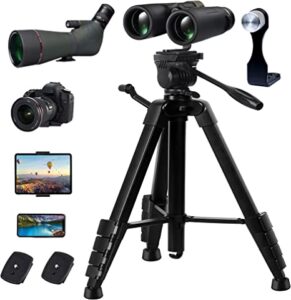
The LCNCY tripod can support 11 pounds, ensuring camera stability. Shaky shots no longer disappoint. With the LCNCY tripod, you can concentrate on your art.
Rise Higher
The LCNCY tripod’s 60-inch height lets you shoot higher. This tool lets you shoot from unusual angles, adding depth and originality. This tripod’s height adaptability allows for stunning landscapes and dynamic portraits.
Easy Changes
The LCNCY tripod’s pan head makes camera tilting easy. Smooth changes replace difficult positions. This capability is useful for capturing fast-paced action or smoothly panning a scene.
Photographers’ Best Friend
Compact and portable
The LCNCY tripod is ultra-portable at 10 x 2 x 2.7 inches and 2.2 pounds. Put it in your camera bag and go! Its small weight lets you carry it on all your photography travels.
Best Versatility
The LCNCY tripod is versatile due to its height adjustments. This tripod handles macro and landscape photography with ease.
Simple Setup and Use
No more time-consuming setups. User-friendly design makes LCNCY tripod setup easy. You can work without distractions, perfect for beginners and pros.
LCNCY Tripod Improves Photography
Dependable Quality
LCNCY tripods are high-quality. This tripod will last throughout your photography career.
Be Creative
LCNCY tripods enable you realise your artistic vision. Its stability and versatility let you try new angles and techniques, expanding your photography talents.
Improve Results
The LCNCY tripod improves photographs and movies for beginners and pros. Sharper photos, smoother films, and more confidence in your photography skills.
Conclusion
The LCNCY tripod is a game-changer for photographers who want stability, mobility, and precision. Its lightweight, sturdy design and easy adjustability make it ideal for taking great photos. The LCNCY tripod is ready to help you improve your photography. This camera support lets your imagination run wild.
Must Read: Best zoom binoculars 2023
Pros:
- Adjustable height for various shooting situations.
- Can hold up to 11 pounds of weight
- Has a maximum height of 60 inches
- Compact dimensions of 10 x 2 x 2.7 inches for portability.
- Great choice for beginners and professionals alike
Core feature
| Material | Aluminum |
| Item Weight | 2.2 Pounds |
| Weight Limit | 11 Pounds |
| Maximum Height | 60 Inches |
| Tripod Head Type | Pan Heads |
| Product Dimensions | 10 x 2 x 2.7 inches |
| Item Weight | 2.2 pounds |
3)Celestron 93612 Tripod

the Celestron 93612. This aluminium tripod is lightweight and strong, holding up to 5.28 pounds. The Celestron 93612 tripod is perfect for shooting breathtaking views or stargazing. Let’s explore its characteristics and why professionals and beginners love it.
1. Lightweight and Durable
The Celestron 93612 tripod is lightweight and strong, made of aluminium. It can easily support big equipment during photography or astronomy at 5.28 pounds.
2. Angle-Optimal Height
This tripod’s 9.1-inch height allows for several angle photos. The Celestron 93612 tripod can handle low-angle shots and aerial views.
3. Easy Pan Head
The tripod head’s pan/tilt mechanism lets you control your camera’s angle. Adjusting the camera position is easy, letting you frame your images exactly.
4. Quick-Release Plate
The Celestron 93612 tripod’s quick-release plate simplifies instrument switching. It saves time and prevents missed moments while changing equipment.
5. Stability-enhancing Bubble Level
Astronomy and photography require sturdy bases. A bubble level on the Celestron 93612 tripod keeps your device level for clearer shots and accurate observations.
6. Broad Compatibility
This tripod works with many cameras and optical equipment. The Celestron 93612 tripod supports DSLRs, mirrorless cameras, and spotting scopes.
Conclusion
In conclusion, photographers and astronomers looking for a reliable, adaptable, and user-friendly tripod may choose the Celestron 93612. Its strong design, pan head, and quick-release plate make it excellent for taking stunning photos or witnessing cosmic marvels. The bubble level also keeps your creativity stable. The Celestron 93612 tripod improves photography and astronomy. Buy this amazing tripod and watch your talents soar!
Must Read: Best binoculars under 200 2023
Pros:
- Lightweight and sturdy
- Can hold up to 5.28 pounds of weight
- Has a maximum height of 9.1 inches
- Compatible with cameras
- Compatible with a range of cameras and equipment.
Core feature
| Brand | Celestron |
| Color | Black |
| Compatible Devices | Camera |
| Material | Aluminum |
| Item Weight | 2.4 Kilograms |
| Product Dimensions | 9.1 x 9.1 x 9.1 inches |
| Item Weight | 5.28 pounds |
4)KINGJOY Binoculars Tripod
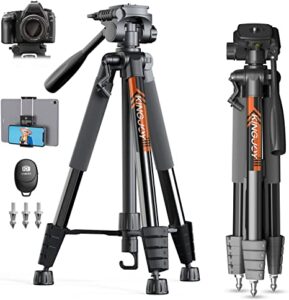
The high-quality aluminium KINGJOY binoculars tripod is precision-engineered. Its sturdy structure keeps your pricey gear safe after continuous use. This tripod will let you spot rare birds and distant stars.
Smooth Pan Head Adjustments
This tripod’s pan head makes camera angle adjustments easy. Avoid continuous setup adjustments. Pan smoothly and capture every moment with the KINGJOY binoculars tripod.
Minimalistic Design
The KINGJOY binoculars tripod is small and light despite its strength. Its 17.75 x 4.75 x 4.63-inch size and 3.74-pound weight make it easy to transport.
All-Skills Companion
This tripod suits beginners and experts. Its simple setup eliminates frustration. Birdwatch or stargaze without complicated gear.
Tablet Holder Unleash Creativity
The KINGJOY binoculars tripod has a tablet holder. The tripod can hold your tablet, broadening your field options. This feature lets you use applications, guides, and star maps to maximise your trips.
Outdoor Durability
KINGJOY binoculars tripods are sturdy and trustworthy for outdoor activities. Its sturdy construction makes it excellent for nature lovers who explore different terrains and weather situations.
Last Words
Birdwatchers, astronomers, and outdoor enthusiasts will love the KINGJOY binoculars tripod. Its durability, ease of use, and versatility make it a must-have for recording amazing moments. With this top-tier tripod, you can confidently go on amazing experiences. The KINGJOY binoculars tripod awaits your next adventure into nature and the cosmos.
Must Read: Best binoculars for boating 2023
Pros:
- Sturdy enough to hold up to 5 kilograms of weight
- Has a maximum height of 75 inches
- Easy to set up and use
- Great choice for birdwatchers and astronomers
- Can hold up to 5 kilograms of weight, making it suitable for heavier binoculars or cameras.
Core feature
| Material | Aluminum |
| Weight Limit | 5 Kilograms |
| Maximum Height | 75 Inches |
| Tripod Head Type | Pan Heads |
| Package Dimensions | 17.75 x 4.75 x 4.63 inches |
| Item Weight | 3.74 pounds |
5)JOILCAN Binoculars Tripod
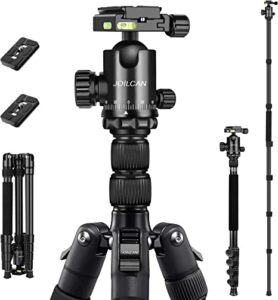
JOILCAN binoculars tripods are essential. This tripod will improve your photography and help you take stunning photos from different perspectives. Let’s examine this top-notch product and see why it’s unique.
1. 81-inch height for maximum flexibility
The JOILCAN binoculars tripod has a maximum height of 81 inches, giving you maximum freedom to get the perfect shot. This tripod lets you easily alter its height for stargazing or birdwatching. This amazing invention eliminates missed moments due to tripod height.
2. Precision Adjustment Ball Head
The ball-headed JOILCAN tripod improves manoeuvrability and precision. This ingenious design gently rotates binoculars or cameras for the finest view. This tripod’s ball head makes panning to follow a bird in flight or monitoring celestial objects across the night sky smooth, enhancing your shooting experience.
3. Portable Design
The tiny and lightweight JOILCAN binoculars tripod is a noteworthy feature. This tripod is lightweight and portable, perfect for outdoor enthusiasts and adventurers. It’s lightweight, so you may enjoy hiking, birdwatching, and stargazing without feeling burdened.
4. Robust Construction
The durable JOILCAN binoculars tripod is made of high-quality materials. Even under harsh outdoor situations, its sturdy structure assures stability. This durability protects your expensive binoculars or camera while you capture extraordinary moments.
Leg Diameter
Tripod legs stabilise and balance it. The JOILCAN tripod balances rigidity and portability with 30 mm leg diameter. You may confidently set up your equipment on rough or uneven terrain, knowing that your tripod will hold solid and protect your gear.
In conclusion
In conclusion, the JOILCAN binoculars tripod revolutionises birdwatching, astronomy, and outdoor activities. It’s ideal for photography due to its amazing height, versatile ball head, lightweight design, and durability. This tripod eliminates blurry photographs and limited angles for spectacular photos and enduring memories. So grab the JOILCAN binoculars tripod and go on an unforgettable visual adventure!
Must Read: Best binoculars for deer hunting 2023
Pros:
- Has a maximum height of 81 inches
- Ball head allows for more flexibility and precise adjustments
- Durable and can hold up to rough use
- Great choice for birdwatchers and astronomers
- Easy to set up and use, making it suitable for both beginners and professionals.
Core feature
| Maximum Height | 81 Inches |
| Tripod Head Type | Ball Heads |
| Minimum Height | 7.5 Inches |
| Leg Diameter | 30 Millimeters |
| Product Dimensions | 16.5 x 2.5 x 2.5 inches |
| Item Weight | 5.13 pounds |
6)Victiv Binoculars Tripod
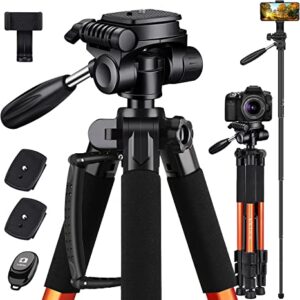
Aluminium makes the Victiv Binoculars Tripod portable and durable. It’s lightweight and strong enough to support your gear.
Easy Camera Adjustment Pan Head
This tripod’s pan head makes camera angle adjustments easy. Smooth panning replaces awkward adjustments.
Performance-optimal dimensions
The Victiv tripod’s 23.4 x 4.3 x 4.3-inch proportions are suitable for mobility and functionality. Its tiny size makes it easy to transport while offering stability for your creative projects.
For Beginners and Experts
Photographers of all levels prefer the Victiv Binoculars Tripod. It’s easy to use but performs well enough for specialists.
Creative 3-Way Swivel Capability
Fluid Pan
The tripod’s 3-way swivel lets you take stunning panoramas. Create captivating images by effortlessly panning.
Effective Tilting
Tilt easily to frame your photos. This tripod ensures perfect composition for photography and filming.
Follow Moving Objects
The 3-way swivel lets you track moving subjects. Photograph wildlife and athletes with precision.
Best Stability and Security
Flexible Height
Tripod height increases inventiveness. This tool lets you try several shooting tactics, from ground-level to high.
Stable Feet
Concerned about unevenness? Fear not! The Victiv Binoculars Tripod has non-slip feet for stability on any surface.
Conclusion
The Victiv Binoculars Tripod is a great tool for photographers and videographers. The pan head makes camera adjustments easy, and its aluminium structure is durable and portable. This tripod suits all skill levels. The 3-way swivel lets you take smooth, seamless photos, making it ideal for dynamic subjects. This tripod will support your creativity with adjustable height and non-slip feet. Use the Victiv Binoculars Tripod to enhance your visual narrative.
Must Read: Best binoculars for elk hunting 2023
Pros:
- Lightweight and sturdy
- Can hold up to 1800 grams of weight
- Has a maximum height of 23.4 inches
- Compatible with cameras
- Tablet holder and extended durability make it a reliable option for a wide range of outdoor activities.
Core feature
| Brand | Victiv |
| Color | ORANGE |
| Compatible Devices | Camera |
| Material | Aluminum |
| Item Weight | 1800 Grams |
| Product Dimensions | 23.4 x 4.3 x 4.3 inches |
| Item Weight | 3.97 pounds |
7)LCNCY Binoculars Tripod
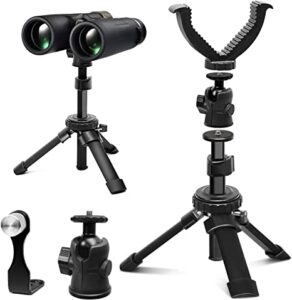
LCNCY Binoculars Tripod is sturdy and reliable. Its lightweight aluminium structure makes it durable and easy to tote on outdoor adventures. This tripod will support your binoculars or spotting scope in tough terrain or dense woodlands.
Capture Nature’s Beauty
The LCNCY Binoculars Tripod lets you see nature from different angles at 7.8 inches. Its adaptability lets birdwatchers easily see birds in their native environments. Its movable legs let you modify the height and position to never miss a moment.
bThe LCNCY Binoculars Tripod lightens outdoor adventures at 1.37 pounds. Its small weight lets you focus on birdwatching rather than carrying hefty gear. This tripod is reliable for day hikes and multi-day camping trips.
For Novices and Experts
New birdwatchers and outdoor explorers will love the LCNCY Binoculars Tripod. Its easy assembly lets you see nature’s wonders right away. Unfold, adjust, and go.
Spottingscope Compatibility
This tripod works with spotting scopes and binoculars. The LCNCY Binoculars Tripod is ideal for photographing faraway wildlife. Nature lovers and wildlife photographers need it because its sturdy platform and smooth panning movements let you track topics precisely.
Conclusion
Birdwatchers and outdoor enthusiasts will love the LCNCY Binoculars Tripod. Its lightweight, strong aluminium structure ensures stability without compromising portability. Its flexible legs and spotting scope compatibility allow for 360-degree exploration of nature. This tripod will be essential for birdwatchers of all levels. With the LCNCY Binoculars Tripod, you can confidently explore nature.
Must Read: Best binoculars for wildlife viewing 2023
Pros:
- Lightweight and sturdy
- Can hold up to 1.37 pounds of weight
- Has a maximum height of 7.8 inches
- Easy to set up and use
- Great choice for beginners and outdoor enthusiasts
Core feature
| Brand | LCNCY |
| Color | black |
| Material | Aluminum |
| Product Dimensions | 2.7 x 2.7 x 7.8 inches |
| Item Weight | 1.37 pounds |
Best tripod for binoculars 2023-Complete Buying Guide
Finding the best tripod for binoculars can be a daunting task. With so many models available, it can be difficult to determine which one will work best for you and your viewing needs. The right tripod should offer stability and adjustability to ensure the most comfortable and clear viewing experience.
This guide will provide an overview of the features and considerations that go into choosing the best tripod for binoculars, as well as reviews of some of the top products on the market in 2023. We also provide tips on maintaining your tripod to ensure optimal performance over time.
After reading this guide, you should have a better understanding of what is important when choosing a binocular tripod, as well as confidence in your ability to make a decision that meets your needs.
Importance of tripods for binoculars
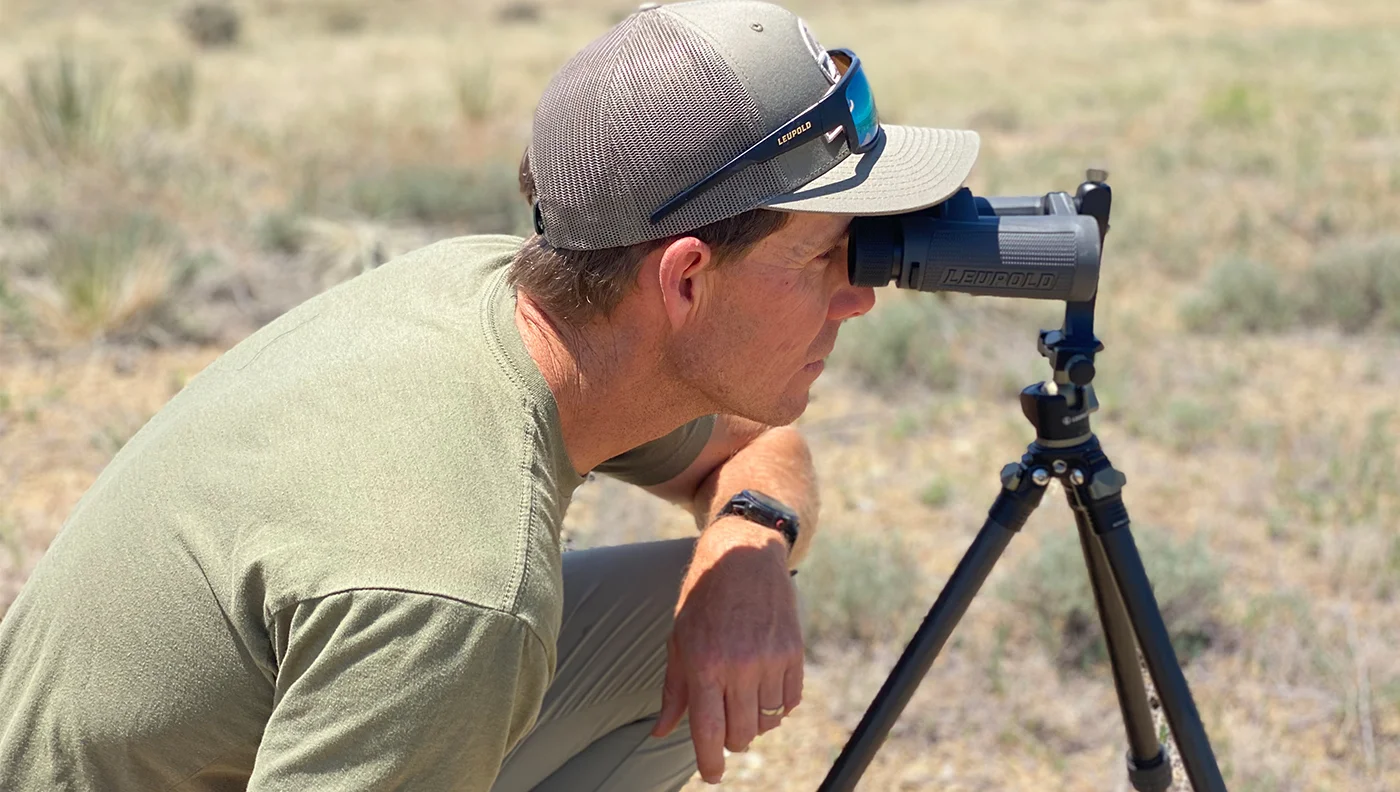
Photo Source :fieldandstream.com
Tripods are essential pieces of equipment for anyone planning to use binoculars as a means of observing distant objects. Using a tripod will stabilize your binoculars and prevent them from shaking or wobbling, thereby providing you with clearer, more focused images and helping you identify details better. Tripods also reduce eye fatigue that can come from having to continuously hold your binoculars when looking at relatively distant objects.
Furthermore, tripods make it easier for multiple people to share their views without worrying about the image being unclear or blurred due to shaky optics. A good tripod can provide an extra layer of comfort which ultimately translates into more enjoyment during the viewing experience. This is especially true for night sky observations like star gazing, where more powerful magnification requires extra stability – something that only a solid tripod can provide.
Purpose of the guide
The purpose of this guide is to provide information on the latest binocular tripods available in the market and help buyers make an informed decision while shopping. We will discuss various features, advantages and disadvantages of different types of tripods and compare models from reputed brands.
This guide will also provide tips on how to choose the best tripod for your binoculars and explain why it is important to invest in a reliable one. Whether you are a beginner or veteran birder, this guide will go through each option available to make sure you find a tripod that is perfect for your needs.
Factors to consider when choosing a tripod
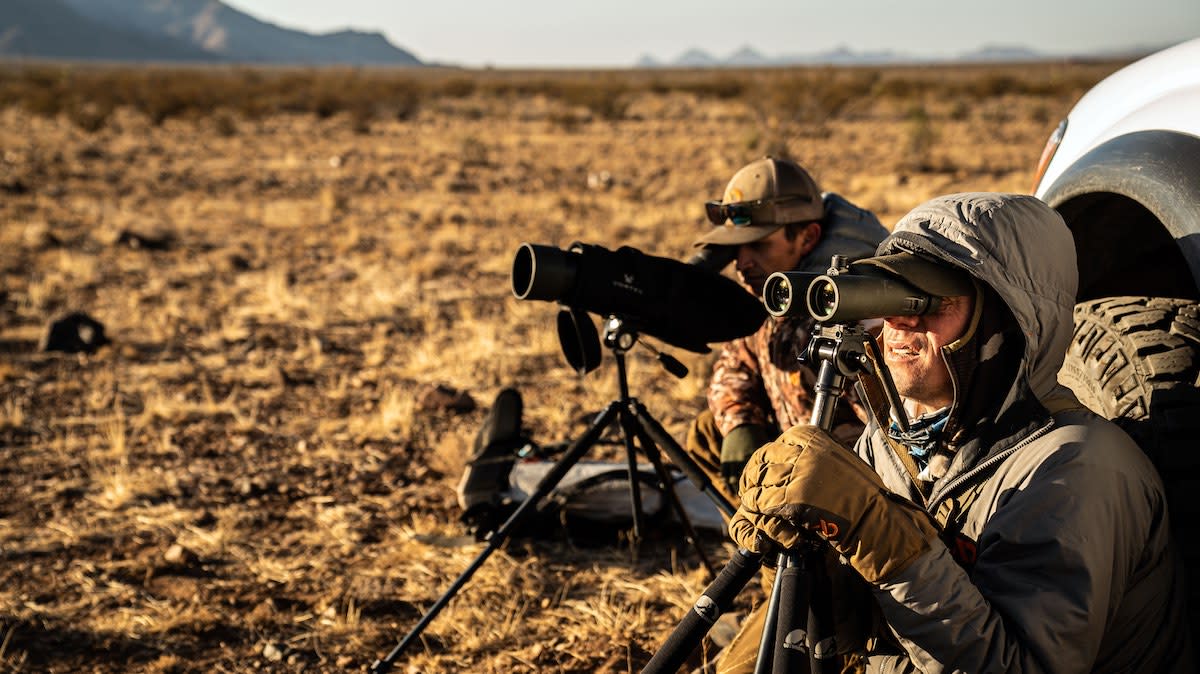
Photo Source :themeateater.com
When choosing the best tripod for binoculars, there are several factors to consider. It is important to select a tripod that is strong enough to support the weight of your binoculars, as well as tall and steady enough to allow you to comfortably use them from a standing position. Other important considerations include the size and type of tripod head, adjustability, portability, ease of setup, and cost.
Tripod Strength: Most tripods can generally support up to 15 lbs of weight but some models may be able to handle more. The legs should be constructed from durable materials such as aluminum or steel and should have rubber or foam grips for comfort when holding them for longer periods of time. If your binoculars weigh more than 15 lbs., it is recommended that you invest in a larger tripod with greater strength and stability.
Height & Stability: When selecting your ideal tripod, it is important to ensure that it meets your height needs and provides adequate stability while operating your binoculars at full zoom levels. For example, the Vixen Optics Giro mount tripod can accommodate users ranging in height from 4’6” – 6’3” (1.4 m – 1.9 m), making it an excellent option for bird watching or other outdoor activities requiring magnification on certain objects at great distances away. Additionally, look for adjustable/optional leg length extensions if you plan on using the tripod indoors or require greater versatility for various viewing situations or preferences.
Tripod Head: The type of head you choose will ultimately depend on how you plan on using your new gear and what type of material(s) need(s) to be supported (eg., spotting scope and/or binoculars). There are several types from which to choose including conventional pan/tilt heads (ball heads), gimbal heads ( favored by birdwatchers as they allow easier tracking movements ) and photo heads designed specifically for cameras with telephoto lenses . If you opt for a pan/tilt model , make sure it has built-in resistance knobs so that finer adjustments can be made while looking through the lens . Also ensure that any selected head includes quick release plates(typically Arca-Swiss compatible) so that objects attached can be easily swapped between multiple devices if desired – this is especially useful if planning on alternating between terrestrial (binoculars )and celestial views (spotting scope ).
Portability: Although some larger tripods require assembly prior to usage , one should also consider portability when purchasing one as novices may prefer something lightweight/collapsible versus something bulkier in size . Look for models featuring adjustable legs that can accept different length telescoping sections allowing users the ability adjust total height without sacrificing too much poundage given their travel destination . Additionally , most reasonable priced equipment comes with its own carrying bag although those made from heavier grade materials typically require separate purchase .
Setup & Cost: You will also want to keep an eye out for ones offering quick & easy setups via leg locks mechanism as this often saves valuable time when trying insure proper balance before taking aim at observing your target . Finally , shop around though various retailers such us Amazon / eBay / B&H photo etc …for best deals possible although one should always remember “you get what you pay
Stability
When it comes to choosing a tripod for binoculars, one of the most important features to consider is stability. You want a tripod that will be able to hold your binoculars firmly and not vibrate when you use them. This is especially important when trying to spot distant objects and avoid shaking or unsteady images.
There are several components of a tripod that affect its stability, such as its legs, feet, center column, and head type. Generally speaking, tripods with thicker legs and feet provide more stability than those with thin or short legs and feet. Tripods with adjustable center columns will also help provide increased stability. Additionally, tripods with three-way heads are more stable than those with ball heads because the three-way head can be locked in each axis for more control over movement.
Other factors that contribute to the stability of a tripod include its weight and construction material. Heavier tripods have more mass which makes them less susceptible to vibration or movement. Also, tripods made from aluminum tend to be heavier and sturdier than carbon fiber options which generally offer lighter (but less sturdy) support for binoculars or spotting scopes.
Weight and portability
When considering a tripod for the best way to mount your binoculars, one of the primary considerations should be weight and portability. Depending on your preference, portability might vary from being able to carry your tripod around with ease to easily fitting into your backpack so you don’t have to lug it around.
Lower-end tripods that incorporate aluminum or fiberglass can be lightweight but can also add some unwelcomed weight if you’re looking for a less bulky option. Carbon fiber tripods tend to be significantly lighter than metal or other materials and can offer better stability without adding much weight. Pay close attention to the attachment method as this has a major effect on the setup of the tripod and its overall weight as well.
In terms of portability, adjustable leg angles come in handy especially when trying to find balance on an uneven surface or because of extreme temperatures. Furthermore, check if there is a hook that allows you to hang additional weight onto the center shaft but always make sure not do add too much weight as this can lead to instability or even damage!
Height and adjustability
The height and adjustability of a tripod are an important consideration. Most tripods will come standard with legs that can be extended to increase the overall height of the tripod. When you are using your binoculars for extended periods, or in less than ideal terrain, it’s important that you have a tripod that is tall enough for you to be comfortable. Look for a tripod with adjustable or extendable legs so you can find the perfect fit without having to purchase extra pieces.
It’s also important to consider how adjustable the head is on your tripod. Many tripods will come with an adjustable pan and tilt head, allowing you to easily adjust the angle of your view. This is especially useful when viewing at various angles, as it allows you to make quick changes without having to reset your whole setup each time. Some tripods may even have heads that allow tracking and panning if that’s something you feel would benefit your viewing experience.
Types of tripods for binoculars
When it comes to purchasing binocular tripods, you have multiple types to choose from. Depending on your needs and preferences, you can find the perfect type for your binoculars. Here are some of the different types available:
*Monopod Tripods – These types of tripods require only a single leg, and they’re generally a little more portable than other types due to their small size. Monopod tripods are perfect for on-the-go use and can be used in situations when more space is limited. However, because they aren’t as stable as traditional tripods, they’re best suited for smaller binoculars such as pocket or mid-sized models.
*Tabletop Tripods – Tabletop tripods are lightweight yet sturdy and provide a great standing base for any pair of binoculars or spotting scope. These types of tripods generally feature three legs; two with adjustable length and one that detaches from the base plate so you can mount it on a tabletop or other flat surface. Generally speaking, tabletop tripods provide good stability when placed on flat surfaces like tables, counters and so forth.
*Full Size Tripod –Full size tripod setups offer the most stability compared to any other option in terms of holding heavier equipment such as large binoculars or spotting scopes securely and firmly in place. They provide sturdiness similar to that of a monopod but also offer portability- like a traditional tripod setup thanks to its adjustable legs with removable feet. It’s worth mentioning that most full size tripod heads feature rotating handles so you can quickly adjust the center column height depending on your needs throughout the day.
Tabletop tripods
Tabletop tripods are an excellent choice for anyone looking to set their binoculars up quickly and easily. They are lightweight, compact and can be positioned freely on any flat surface with their adjustable mount heads.
Tabletop tripods come in a range of sizes, with some large enough to accommodate heavier binoculars while some are designed specifically for smaller binoculars. Some models feature 3-way head movement, making it easy to adjust the angle of your binoculars as needed.
While tabletop tripods may not provide the stability of a full-size tripod, they still provide excellent support and balance for even the most challenging viewing tasks.
Compact tripods
Compact tripods are lightweight and portable, making them the perfect companion for outdoor activities such as birding and hunting. They usually weigh less than 10lbs, making them easy to carry.
When it comes to buying a compact tripod for your binoculars, there are a few important things to consider. First, you should make sure the tripod is durable enough to support the weight of your binoculars. Additionally, look for a tripod that has adjustable legs so you can set it up in any terrain. The locks should also be easy to use and reliable, that way you don’t have to worry about the legs slipping out of place while you’re out in the field.
Make sure the center column is strong enough to handle heavy loads because this is what will keep your binoculars steady while they are in use. Lastly, look for features such as quick release plates or telescopes handles so you can adjust your binoculars quickly and easily without having to mess with knobs or other parts of your tripod.
Full-size tripods
Full-size tripods are the most rigid and provide the best stability for binoculars. They come in many different sizes and materials but typically use threaded legs that can be extended and locked in place at different heights. Some also offer additional features like quick release plates, leg spikes, and leg warmers which can make the tripod useful in different situations.
The most important feature of a full-size tripod is that it always has 3 contact points with the surface. This provides better stability and helps reduce shake while using your binoculars. You also want to look for one that has adjustable tension settings so you can fine-tune the stability of your equipment depending on the conditions you’re in. Additionally, you may want to consider tripods made with carbon fiber or aluminum materials as they tend to provide better performance than their plastic counterparts.
Conclusion
In conclusion, tripods are designed to provide extra stability for your binoculars so that you can experience the best viewing experience possible. They come in a variety of shapes, sizes and materials so you can choose one that is perfect for your needs and preferences. For instance, lightweight and portable tripods are great for those who need to set up quickly and move around often, while heavier and more robust models offer more stability when viewing heavier binoculars.
In addition to these factors, make sure you consider the type of head that is included with the tripod. Different heads provide different levels of maneuverability, so choose one that allows you to make easy adjustments while using your binoculars. Finally, remember that most tripods are fairly inexpensive yet can make a huge difference in how well you view the outdoors with your binoculars.
FAQ’s
Can I put my binoculars on a tripod?
Yes, binoculars can be mounted on a tripod using a tripod adapter.
Do you need a tripod for 10×42 binoculars?
While it is not necessary to use a tripod with 10×42 binoculars, it can provide a more stable viewing experience, especially for extended periods or when using higher magnification.
What do I need to mount binoculars to tripod?
You will need a tripod adapter that is compatible with your binoculars and tripod. These adapters can be purchased separately or may come included with some binocular models.
Which binocular is best to see planets?
Binoculars with a larger aperture and magnification, such as 15×70 or 20×80, are best suited for viewing planets.
Do you need a tripod for 12x binoculars?
Using a tripod is recommended when using 12x binoculars, as the high magnification can make the image more shaky and difficult to hold steady for extended periods.
How do I choose a tripod height?
Choose a tripod height that is comfortable for you to use while sitting or standing. A good rule of thumb is to choose a tripod that extends to the height of your eyes when standing.
How do you tripod binoculars?
To tripod binoculars, attach the tripod adapter to the binoculars, then attach the adapter to the tripod head. Adjust the height and angle of the binoculars as needed for comfortable viewing.
Is a monopod good for binoculars?
While a monopod can provide some stability when using binoculars, it is not as stable as a tripod and may not be suitable for extended viewing periods or higher magnifications.
How do you stabilize binoculars without a tripod?
One way to stabilize binoculars without a tripod is to brace your elbows against a solid surface, such as a tree or wall, while holding the binoculars. Alternatively, you can try sitting down and resting your elbows on your knees.
Can I attach my phone to my binoculars?
Yes, there are phone adapters available that allow you to attach your phone to your binoculars for taking pictures or recording videos.
